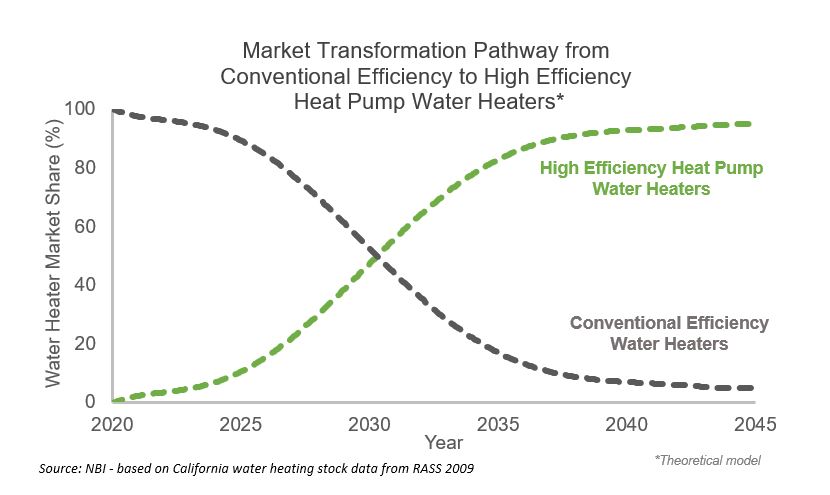It takes a village to change technology. We in the efficiency industry have witnessed decades of partnerships to bring transformative change to refrigerators, lighting, motors and HVAC. With increasing concern over the energy use and greenhouse gas (GHG) emissions associated with heating water, it is time to bring heat pump water heaters (HPWHs), a technology that has been in the market for decades, into the mainstream.
Over the last year, more than 90 people representing 35 organizations have joined the Advanced Water Heating Initiative in a multi-year effort to overcome market barriers and catalyze a transition to a robust HPWH market. The market transformation effort, an initiative of New Buildings Institute and the Building Decarbonization Coalition, convenes utilities, government agencies, manufacturers, researchers, advocates, and building industry professionals throughout California and the Pacific Northwest to create a community, share knowledge, develop strategy and work products toward this goal.
The initiative’s diverse member base and dedicated working groups are engaged in solutions that will enable greater penetration of high-efficiency, grid-connected HPWHs. Members are strategically addressing market barriers, coordinating research, developing technology roadmaps, educating the market, and advancing programs and policies that will jumpstart the market for this technology.
Decarbonizing California
In order to meet their landmark 2045 carbon neutrality goal, the State of California will need to reduce and avoid existing emissions across all sectors, and proactively pursue negative emission pathways, according to a January 2020 report by the Lawrence Livermore National Laboratory. With buildings being responsible for an estimated 25% of the state’s climate emissions, it’s critical that the state address energy use and emissions in both new and existing buildings. The figure below reflects the intent to dramatically increase HPWH adoption by 2030 to support these goals.

In the residential sector, heating water for showers and other domestic uses with gas water heaters is the largest use of energy in the average California home–before space heating–responsible for 40% of household energy use. The vast majority of California homes (over 90%) rely on gas and propane combustion water heaters and water heating. HPWHs are a highly efficient decarbonization solution offering two to four times the efficiency of conventional efficiency water heaters. They have the potential to respond to “time-of-use” rate structures that favor energy use during high renewable energy production periods. As a result, they can drastically reduce the energy and emissions associated with a homeowner’s hot water use.
The figure below shows 50% energy and 77% emissions reductions in Southern California from a conventional refrigerant HPWH (R-134A) and more with the use of CO2-based refrigerants (r-744) which has little to no global warming potential (GWP). Currently there is only one product with CO2 refrigerant available for the residential market, but more options are anticipated in the years ahead.
 While over 90% of California homes rely on gas and propane combustion water heaters, approximately 50% of homes in the Pacific Northwest have gas and propane combustion-based water heaters, and approximately 50% have electric resistance-based models. The region’s electricity generation comes primarily from hydropower with a few areas served by gas and coal-fired electricity and/or peak power that may come from fossil-fuel-based sources. These market and source-energy characteristics create unique drivers for the Pacific Northwest market that are also supported through the Advanced Water Heating Initiative.
While over 90% of California homes rely on gas and propane combustion water heaters, approximately 50% of homes in the Pacific Northwest have gas and propane combustion-based water heaters, and approximately 50% have electric resistance-based models. The region’s electricity generation comes primarily from hydropower with a few areas served by gas and coal-fired electricity and/or peak power that may come from fossil-fuel-based sources. These market and source-energy characteristics create unique drivers for the Pacific Northwest market that are also supported through the Advanced Water Heating Initiative.
Turning the tide
Forty-five members engaged in the Advanced Water Heating Initiative have joined four working groups to specifically address the following:
- Unitary 240V heat pump water heaters
- Unitary 120V heat pump water heaters
- Central heat pump water heaters for multifamily housing
- Connectivity and controls, for grid-connectivity and demand management
By facilitating and strategically coordinating with each of these groups and their work plans, the initiative more efficiently and cost-effectively helps to define technology constraints and opportunities while increasing manufacturer, utility, and consumer awareness. For example, installer training and consumer marketing campaigns for single-family residential markets look different from those targeting the multifamily market. Yet they should be coordinated and consistent in order to have the greatest possible impact. The same holds true for utility programs and changes to building energy codes.
Tackling barriers: technology, market and regulatory
Examples of technical barriers (and resulting impacts) being addressed through the Advanced Water Heating Initiative include the lack of:
- product awareness and the value proposition (low consumer demand);
- supply chain awareness and confidence in sales volume (low product availability);
- technology familiarity and available support for installers (resistance to installation);
- sufficient sharing of data regarding system performance and grid benefits to offset utility peak demands (few utility incentives programs);
- consumer and policymaker awareness about the health benefits of shifting to fossil-fuel -free technologies, which reduce pollution both indoors and outdoors (low consumer demand and lack of additional non-energy incentives);
Equity, Investments, and Policies
The electrification of water heating is a critical aspect of reducing emissions from buildings. AHWI has promising benefits, but it must be pursued equitably. Those of us in the efficiency industry who have witnessed decades of transformative change must now turn our full attention to ensuring that that equity is key in program design and policy making. Studies are outlining equity challenges that, just like these technical ones, must be addressed. It will require intentionality and a planned transition to ensure that social justice communities benefit.
In January 2020, the CPUC allocated $45 million for incentives for HPWHs through 2025 and is considering 15 different electrification programs across multiple proceedings, including $4 million for low-income residents. In July this year, the CEC adopted a new appendix to the state’s building energy code, called “Joint Appendix 13” (JA13) that provides criteria for smart, connected electric heat pump water heaters for their grid benefits. Total funding as currently proposed by CPUC is approximately $420 million with several programs incentivizing heat pump water heaters.
These investments, attention to equity in program design, and the Advanced Water Heating Initiative activities, send a strong message to manufacturers that heat pump water heaters are a vital tool for reducing energy burden, improving consumer health, and reaching the aggressive climate goals while also helping utilities solve peak demand issues. It also sends a signal to the more than 50 California cities and counties that have adopted or are considering electrification mandates or preferences for new construction that affordable all-electric technologies are available to help them meet their policy goals.
Join the Advanced Water Heating Initiative*
Keeping a multi-year market transformation effort moving forward amidst a global pandemic that has put millions out of work could be seen as a tough assignment. Yet the nearly 100 people involved in the work of the Advanced Water Heating Initiative are proving there is no better time to work on innovative solutions that address equity, economic, public health, and climate goals.
Help pave the way for a future in which heat pump water heaters are the norm. Contact Amruta Khanolkar, NBI project manager, by email for more information. Sign up to get the latest news by email.
*The AWHI welcomes interest and collaboration beyond the West Coast.
by Amruta Khanolkar, Project Manager
and Cathy Higgins, Research Director


